The best MT4 Trade Manager EA
Created out of the sheer frustration of trading with MT4

A 10 minute process done in 10 seconds. Easily place your entry, stop loss, take profit, breakeven, partial profit, trailing stop and idea invalidation in 2 simple clicks. After that, choose how much you wish to risk for each trade based on lot size, dollar amount of % of equity.
Features of the MT4 Trade Manager EA
Some of its amazing features.
Smart Lot Size Calculation & Recalculation
Reverse calculate your lot size based on equity % or dollar amount $. The EA factors in how far your stop loss is and reverse calculates the correct lot size based on your risk allocation to that trade.
If you adjust your pending order’s stop-loss distance, the EA will automatically recalculate the correct lot size for you and replace the trade with the correct lot size.

1-Click Stop Loss / Take Profit Targets
Place your stop loss and take profit targets with a single click.
Works for market orders and pending orders.

Easily Modify Existing Trades
Adjusting your levels is as easy as clicking and reactivating the setup.
Even if you modify your stop loss distance, the Trade Manager can easily help you recalculate the correct lot size to risk the same original amount.

3 Levels Partial Profits
The Trade Manager EA allows you to set up to 3 separate partial profit levels along with customisable % to be closed at each level.
Very useful for locking in profits at key stages of your trade.

Multiple Trailing Stop Loss
Wide selection of trailing stop loss features, from simple trailing stop, to 3 step trailing stop, to ATR stop loss, Chandelier trailing stop loss and even Parabolic SAR stop loss.
Very useful for riding out large trends or big breakouts that can turn your original winning trade into a massive one.

In-build News Avoidance System
The MT4 Trade Manager EA has the option to remove your pending/opened orders when a big news event is approaching. This prevents you from getting wiped out of your trade because of the wild volatility.
You can set custom timings on when to remove your pending and/or market orders before a news event. High/medium/low impact is fetched from Forex Factory.
In-build Stealth & Decoy Stop Loss / Take Profit Levels
The MT4 Trade Manager EA is able to hide your stop loss and take profit targets from the broker. It can similarly add a decoy X pips to your stop loss or take profit targets to throw your broker off.
This is very useful when you feel that you are being B-booked by your broker or always notice that you get stopped out by 1 pip or so.
When using this feature, you have to keep your trade manager EA turned on (meaning your computer has to be running).

Download and give it a shot
Trial version works on AUDUSD, USDJPY and GBPUSD
Table of Contents
Why does MT4 Trade Management Suck?
Simple, these are the steps to risk 1% of a 100k account on a trade.
Conventional method on MT4 is very tedious and brain draining every time you want to place an order:
- Measure your stop loss distance (in MT4 they show it as pipettes so you need to divide by 10)
- Go to an online position calculator and key in your account balance, base currency and also the symbol you are trading.
- Calculate the required lot size based on how much you wish to lose
- On MT4, place a pending stop/limit order (and pray you don’t screw up)
- Manually type in your stop loss price (and pray you don’t press the wrong numbers)
- If you wish to edit your order, delete the entire trade and repeat.
- Manually adjust stop loss to breakeven
- Manually close % of position when price has moved % towards TP target
What makes our trade manager Different?
Built by traders, for traders.
New MT4 Trade Manager EA method:
- Use the vertical trade bars to easily select your entry, stop loss, take profit, breakeven, partial profit (up to 3 levels), trailing stop loss levels. If you don’t want to use any of them, just press the “X” at the top of the bar.
- Define trade helps you easily select how much you want to risk on each trade
- Choose whether you want any advanced features such as stealth/decoy stop loss. When done, click ‘place trade’.
Done. It can be that simple. You essentially squeezed a 10-minute process into less than 30 seconds.
This MT4 Trade Manager EA works purely based off the charts you attach it on. It was designed to help traders easily define your risk amount (in terms of equity %, lots or absolute dollars), pick your entry, your stop loss and your take profit.
It also has these additional features (which we will cover in detail later).
- Breakeven feature allows you to set the price level where your stop loss would be moved to breakeven
- Partial profits feature allows you to set the price level where you would close partial profits (adjustable % of open position)
- Trailing stop loss feature provides you 4 different trailing stop options to choose from (parabolic SAR, chandelier exit, normal trailing stop, step trailing stop)
- Stealth stop loss feature allows you to hide your stop loss and take profit in case you feel that your broker is hunting your stops (there are brokers who do this)
- Decoy stop loss feature allows you to set a decoy to your stop loss and take profit such that you the MT4 Trade Manger EA would close off your position before TP/SL is hit. This is particularly useful for profit targets as there are many times you notice price reversing right before it hits your profit target – fishy right? This feature allows you to take your profit before that ever happens.
- News filter feature is built because many traders do not want their open/pending positions to be around when high impact news events come around. Example: if you have a pending EURUSD trade, you can choose to delete it 15 minutes before NFP news arrives and open it 15 minutes after NFP news is done. This allows you not to be caught out by the wild volatility of that news event.
- Spread filter feature allows you to get into positions only when spread is in your favour. Brokers like to spike spreads when your entry price is reached, causing you to be slipped negatively (and hence they profiting). What this feature does is that it prevents a pending order from being triggered if the spread is too high and only actives the pending trade when spread tightens to an acceptable level.
Why not have a Fixed stop loss?
My strategy has a fixed X pips stop loss / take profit.
Why do we use intelligent responsive bars to pick all our levels? Why not just have a fixed stop loss and take profit distance?
It’s because you trade off the charts and it’s easier to see which levels you want these important levels to be at. Sure, it shows you the number of pips that your stop loss/take profit has, but what is more important is how these levels look on the entire chart, right?
Not sure what I mean?
Well imagine this: You have a strategy that tells you to set a take profit of 100 pips. If you use a standard approach of just placing 100 pips, you turn a blind eye to what the charts are telling you and that is very very dangerous.
What if your 100 pips take profit is 5 pips higher than a major swing high that has not been successfully passed for the last 3 weeks? Wouldn’t it make more sense to simply have a 95 pips take profit in this case? Why risk the entire profitability of a trade for 5 pips?
Because of this, it’s always better to reference the chart when placing your key stop loss/take profit levels.
Below is a picture example of what I mean when your use a fixed take profit and it causes you to miss your profit target by just a few pips (because it is placed beyond a key level of resistance):

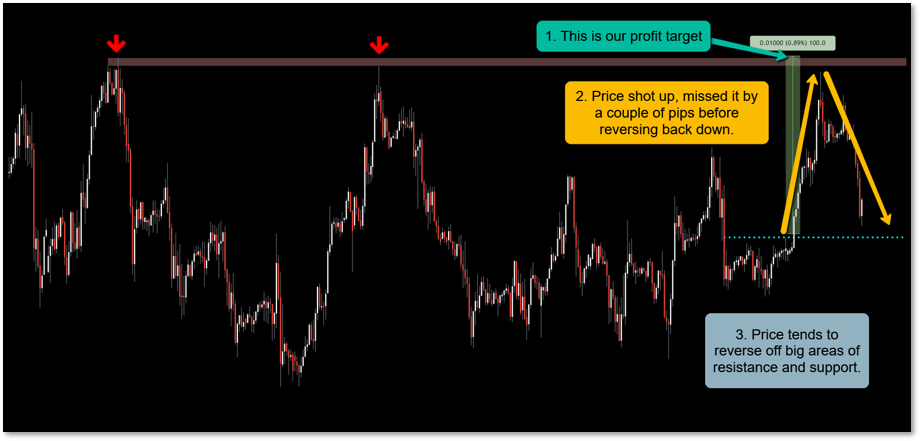

Where should you place your stop loss and take profit levels?
Stop loss = beyond, Take profit = before
Refer to the image below on how it is better to place your stop loss beyond a major level and your take profit before a major level. This would help prevent yourself from getting stopped out right at the big resistance level and also help you avoid situations where you miss your take profit by just a few pips and price reverses to your entry (and even worse, your stop loss. The horror!)

Video of our MT4 Trade Manager EA in action
It’s pretty cool, honestly.
A short preview of how I use the MT4 Trade Manager (this is not the latest version though). You can see how I can now properly focus on my own trading and managing my positions instead of using the shitty MT4 in-built trade management nonsense.
Proper trade management (advanced)
Chief Trader Desmond goes through advanced trade management techniques.
This video is particularly useful to get a holistic understanding of trade management and how you can use it to greatly improve your profitability. It does not entirely revolve around the trade manager, instead, it shows you how proper trade management is done in forex.
To determine proper levels where you can set your take profit, stop loss and even partial profit levels, you essentially need to identify key areas of support or resistance. I recommend you take a look at these articles which I use in my own trading strategy to determine key areas of support and resistance:
- Support and Resistance (the proper way)
- RSI Trading Strategy
- Fibonacci Retracements (how to use them properly)
I highly recommend you watch the video below although it can be quite long. (It’s a webinar I did for one of the brokers in the past to teach their clients how to manage trades properly).
How to use breakeven?
The art of moving your stop loss to your entry to protect your trade.
Breakeven is an important tool to use when it comes to trading. It is basically the level where you recognize that price might reverse and hit your stop loss – hence, you decide to protect your trade by (usually) closing out part of it in profit then moving your stop loss to your entry.
Refer to the image below to get a better understanding on where to place your breakeven.

How to use idea invalidation?
The lesser known brother of breakeven – moving your take profit to entry.
Idea Invalidation is an important trading technique to use in trade management. This is because it’s not only about protecting your profits (which is what breakeven does), but it is also about reducing your losses (which is what idea invalidation does).
Most people aren’t too keen on using this advanced trade management technique because it requires you to admit that your idea is wrong (idea invalidated) and to get the hell out of that position as soon as you can (moving your take profit to entry).
Refer to the image below on how I use this in a trade. I would usually place this Idea Invalidation level right before my stop loss (which is beyond a major area of resistance/support) so that price might touch the idea invalidation level and reverse to entry (getting me out).


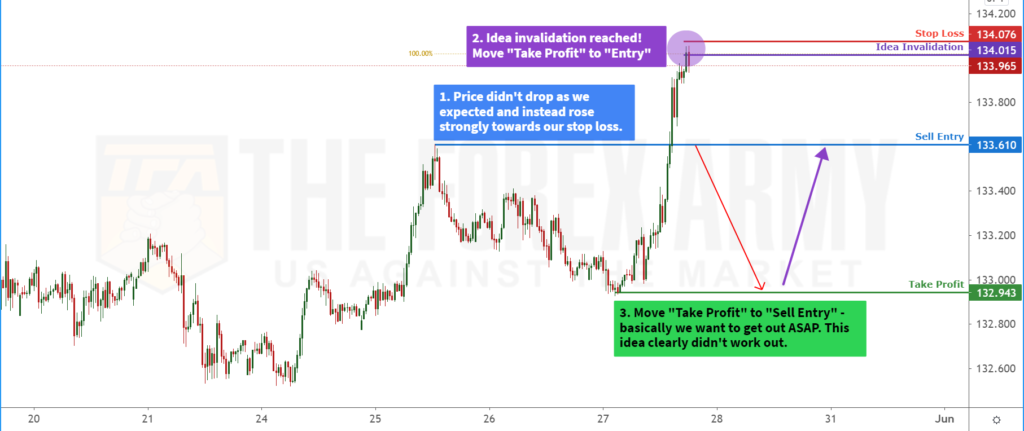


Do you have a video explaining braekeven and idea invalidation?
You know – as it’s darn confusing lol.
In this video, I talk about 2 very important trade management techniques:
- Breakeven
- The art of moving your stop loss to your “entry” price so as to protect your profits.
- Idea Invalidation
- The art of moving your take profit to your “entry” price so as to minimize your losses.
- This is the opposite of the better known “breakeven” technique.
- Used primarily when your initial idea is wrong and you want to get out as soon as possible.
It’s important to know that it’s not just about how much profits you protect. It’s also how much losses you reduce.
This is why both breakeven and its less recognized brother, idea invalidation, are important in your trading strategy.
Please watch the video below as I drill into the concept of breakeven and idea invalidation. It doesn’t revolve entirely around the MT4 Trade Manager so you’ll find it useful even if you trade on tradingview or any other charting software. (It’s a webinar I did for one of the brokers in the past to teach their clients how to manage trades properly).
Trade Management with responsive trade bars
What does each bar mean?
First, clicking “Buy” or “Sell” would open up 7 bars for you to use. To use the bars, all you have to do is click on the specific bar and drag the line up/down to your desired level.
Now, we will go through what each bar stands for :
Blue Bar = Open Price
- The blue bar is adjusted to where you want your order to be triggered.
- If you don’t click and move the blue bar, it will open a market order the moment you click “place trade”.
- If you click and move it, then it will execute a pending order the moment you click “place trade”.

Red Bar = Stop Loss
- The red bar helps you adjust your stop loss.
- It’s important to always repeat the “define trade > risk” settings every time you adjust your stop loss. This will ensure you always have the correct lot size.

Green Bar = Final Take Profit
- The green bar helps you adjust where you want to close your position fully.
- You will need to place your take profit target before placing your partial profit targets (which is between the entry and final take profit).

Yellow Bar = Breakeven
- The yellow bar is your breakeven point.
- What happens when price reaches this level is your stop loss would be moved to your entry.
- This essentially means if price goes back up to your entry and stops you out, you will exit at breakeven (no win no loss).
- Your breakeven level can only exist between your entry to your take profit.
- You can set an automatic offset of X pips to cover your commission.

Purple Bar = Idea Invalidation
- Now, the concept of idea invalidation is not common in the market place yet. But it’s a crucially important tool when it comes to trading.
- Think of it as the “opposite of breakeven”.
- When price reaches this idea invalidation level, your take profit would be moved to your entry.
- The logic behind this is simple : When your original idea is not working, it is best to get out as soon as possible.

White Bar = Cancel Pending Order
- The white bar is there to cancel a pending order when price passes this level.
- The reason for this is sometimes we are looking to sell on a Fibonacci retracement or extension. But when price moves further away, this throws all our calculations off.
- This is an advanced feature. It can be disabled if you prefer to.
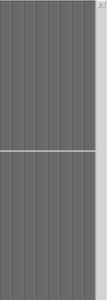
Light Green Bar = Partial profit
- 2 Partial Profit Targets (with adjustable % to be closed)
- Always place your Final Take Profit before placing your partial take profit levels.
- TP1 = 1st partial profit target
- TP2 = 2nd Partial profit target
- TP3 = 3rd (and final) profit target

Pink Bar = Trailing Stop
- The pink bar selects the level at which your trailing stop loss would be activated.
- Currently we have a few popular trailing stop loss methods such as : Simple, Steps, ATR, Chandelier and Parabolic Sar.
- You’ll be able to adjust the settings of each trailing stop loss method once you select them under “advanced”.
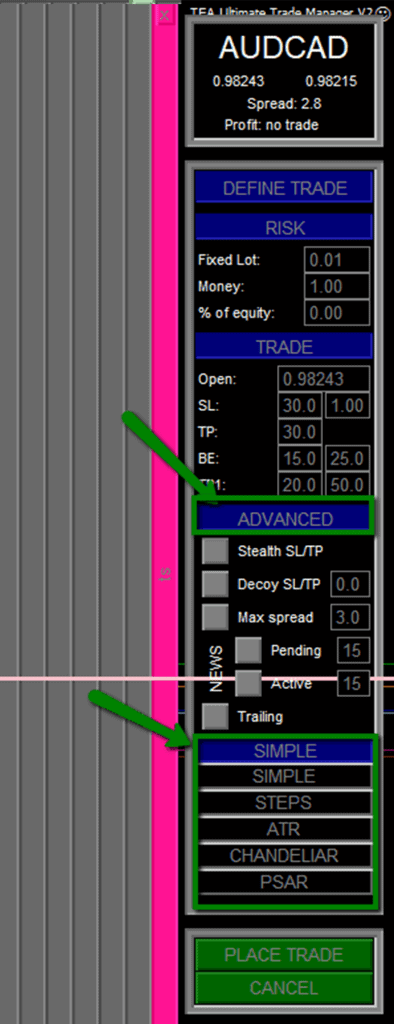
Once you are done picking all the different levels, it is always important to “define your trade”. This step is to help you determine how much you would like to risk on a certain trade. You can choose to risk (only pick one) :
- X dollars
- Fixed number of lots
- Risk % of your account
Trade Manager Basic Settings
Learning how to use it right
- Risk > Fixed Lot allows you to choose a default lot size each time a trade is placed
- Risk > Money lets the trade manager auto reverse calculate your lot size so that it risks the exact amount of money per trade based on your stop loss distance.
- Risk > % of equity is the most recommended setting. It lets the trade manager EA reverse calculate the exact lot size so you’re risking the exact (or as close to) the % of equity on a certain trade.
- Trade > Open simply shows the open price based on the position of the blue bar you used.
- Trade > SL means your stop loss and it shows your stop loss price.
- Trade > TP3 is your dark green bar and also your final take profit where your entire positions (or what is remaining of it) will be closed.
- Trade > BE is your breakeven price. This is where your stop loss is moved to your entry. The box on the right refers to the pips offset. A value of 1.0 means you will move your stop loss to entry +1.0 pips (good to cover commissions.
- Trade > TP1 (box on the right) allows you to state how many % of your position you wish to partially close when that level is hit.
- Trade > TP2 (box on the right) allows you to state how many % of your setup you wish to partially close. This is your second partial profit level.
- Example: Original trade is 1.0 lot. TP1 of 50% means you close 0.5 lots. TP2 of 50% means you close 50% of the remaining 0.50 lots (hence, 0.25 lots). What you’re left with is 0.25 lots for the final take profit target.
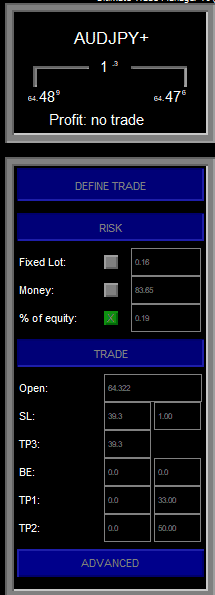
Trade Manager Advanced Settings
Yes, it gets more powerful.
- Stealth SL/TP means to hide your stop loss and take profit from the broker. When you enable this feature, your trades won’t have any stop loss/take profit. It’s important to ensure your MT4 is always running when you use this feature because if you turn it off, the Ultimate Trade Manager would not work and you would be having a trade with no stop loss/take profit.
- Decoy SL/TP means you are able to add X pips to your stop loss/take profit to decoy the broker. Example : your buy order stop loss is at 1.0010. If you add 5 pips decoy to it, your stop loss would be at 1.0005 as seen by the broker, but it is actually at 1.0010 (the Ultimate Trade Manager will recognize this).
- Max Spread feature protects you from being filled on a trade when the spread is too big. For example, you have a pending order on EURUSD. But when price reaches your entry through a volatile news event, the spread is 20 pips. If your Max Spread setting is at 3 pips, the Ultimate Trade Manager protects you by preventing you from entering into a trade until the spread drops to 3 pips.
- News (Pending) feature removes your pending order X minutes before a news event and places it back X minutes after a news event. This is useful especially when you don’t want your trades to be affected by high volatile news events.
- News (Active) feature removes your opened active orders X minutes before a news event so that you don’t get affected by the high volatility news events.
- In both the news features mentioned above, you can adjust whether you want to be affected by high/medium/low impact news and also whether you want the news events to be displayed on the chart (via a vertical dotted line)
- Trailing allows you to select which trailing stop loss method you would like to use.
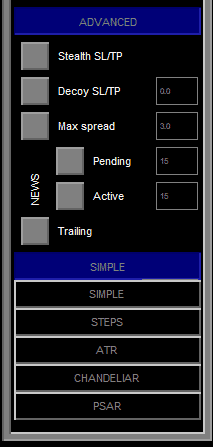
Download and give it a shot
Trial version works on AUDUSD, USDJPY and GBPUSD
Instruction Manual
How do I install this?
The Ultimate Trade Manager.ex4 should be placed in your “expert advisor” folder. To do this, open MT4 > File > Open Data Folder

With the new folder opened, you have to navigate to MQL4 > Experts > paste the Ultimate Trade Manager.ex4 into here.
Once done, restart your MT4.

The next thing you have to do is to enable your MT4 to allow expert advisors. On the top of your MT4, there is a button called “AutoTrading”. Ensure that it is green and not red by clicking on it.

After that, you would need to go to tools > options > Expert Advisors and ensure that the 2 boxes shown in the picture are “checked”

Once you’re done with all that, you have to enable “chart shift” so that the Ultimate Trade Manager has space to operate.
To do that, press F8 > Common > ensure “chart shift” is checked as seen in the picture below.

Once you enable “chart shift”, this nudges your chart to the left giving you some space on the right for the trade manager to be at.
You can adjust how much space you want on the right by sliding the little arrow left/right as seen in the picture below.
Once you’re done with this step, you have successfully installed your Ultimate Trade Manager!

Download and give it a shot
Trial version works on AUDUSD, USDJPY and GBPUSD








